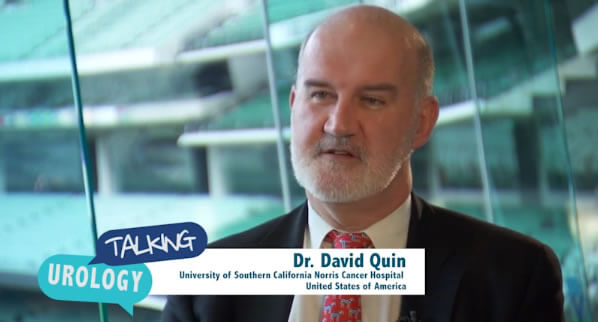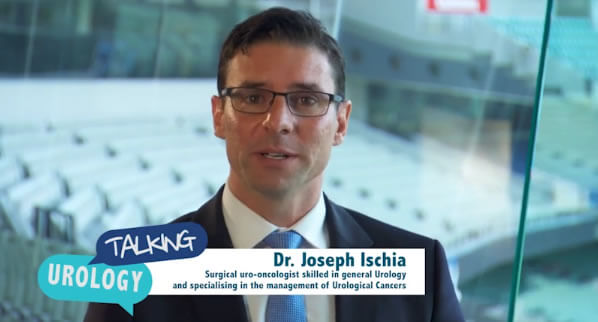ANZUP 2017 – A/Prof Michael Hofman
A/Prof Michael Hofman discusses the new ANZUP/PCFA trial investigating therapeutic Lutetium (Lu-177) PSMA for men with advanced mCRPC.
Talking Urology podcast transcript
ANZUP 2017 Interviews - Ian Davis and Michael Hofman
This Talking Urology ANZUP conference highlight features Ian Davis talking with Michael Hofman regarding the upcoming ANZUP trial looking at lutetium in men with advanced prostate cancer.
Ian Davis: Hello, I’m Ian Davis, a medical oncologist from Melbourne, and I’m chair of ANZUP Cancer Trials Group. I’m here speaking with Associate Professor Michael Hofman. He’s a nuclear medicine physician from the Victorian Comprehensive Cancer Center. Michael we’ve had a pretty exciting week. This week, just yesterday we launched a new clinical trial in collaboration between ANZUP and The Prostate Cancer Foundation of Australia. Can you tell us a little bit about this trial?
Michael Hofman: This is the TheraP trial and it’s a trial using a new agent called Lutetium PSMA, which is a new form of therapy for men with advanced castrate-resistant prostate cancer who have already failed some therapies such as first line chemotherapy or some of the new potent anti-androgen drugs such as Enzalutamide or Abiraterone. This is a randomized multi-center Australian trial, which will compare this new treatment with an already accepted standard of care second line chemotherapy called Cabazitaxel.
Ian: Can you tell us a little bit about the Lutetium PSMA? How does it work and what is—
Michael: Sure. PSMA stands for prostate-specific membrane antigen. This is a small molecule that sits on the surface of prostate cancer cells and it’s there in really high amounts and provides us with a unique target for both the imaging and treatment. We label a small molecule with a radioactive substance and the first thing we do is an advanced scan called a PET scan standing for positron emission tomography. It’s much like a CT scan, but areas of the body which have this PSMA light up very brightly that allows us to see if you’re potentially suitable for this therapy. And then, if you are, we just change the type of radioactivity from a imaging one that travels outside of the body and is detected by the scanner to the lutetium and the lutetium travels only 1 mm, but deposits large amounts of energy directly to the prostate cancer cells while sparing normal tissues in the body that don’t have the PSMA on their cell surface.
Ian: You’ve had some prior experience with this obviously. You know something about the safety and some previous clinical results.
Michael: Correct. The treatment was pioneered by the Heidelberg Group in Germany but we’ve been using it at Peter Mac since 2005 where we started a small first in human trial in 30 patients and these were patients that had already failed all forms of known conventional therapies and some of these patients have had very good responses to this therapy and that has led on to this new ANZUP initiative and Prostate Cancer Foundation of Australia initiative to run a larger multi-center clinical trial against an accepted standard of care to see how it really compares against what we’re doing now.
Ian: We’re very fortunate to have support from ANSTO, the Australian producer of the Lutetium, and ABX who produce the tracer that this molecule binds to. On this clinical trial, many will be randomized to one or the other, what does that mean? If you’re a man who gets randomized to the standard treatment, should that person be feeling disadvantaged? What do you think about that?
Dennis: I guess the Cabazitaxel is an accepted standard of care and there’s already very high- level evidence that that form of therapy prolongs their life and also improves their quality of life. At the time you’re randomized into this trial, I think men can be reassured that they will be at least receiving what is the best-known therapy potentially for that person at that point in time. The newer therapy, everyone likes to get the new therapy, but we don’t know if it’s better than the current accepted of care, so there is some risk there. The way the therapy is administered and side effects are really quite different since one is a chemotherapy-type drug in one is radioactive more targeted molecule, so they’re not directly comparable in that way. But the trial is designed to answer the question of which are better, but we know that the standard of care prolongs life.
Ian: And when can we expect the trial to be open?
Dennis: The trial is currently in a very advanced stage and we expect it to be open in the second half of 2017 and it will run at multiple centers around Australia, so we hope that it’ll be available in each state and it will enroll up to 200 patients.
Ian: Okay, well thank you very much time.
Dennis: Thank you very much.












